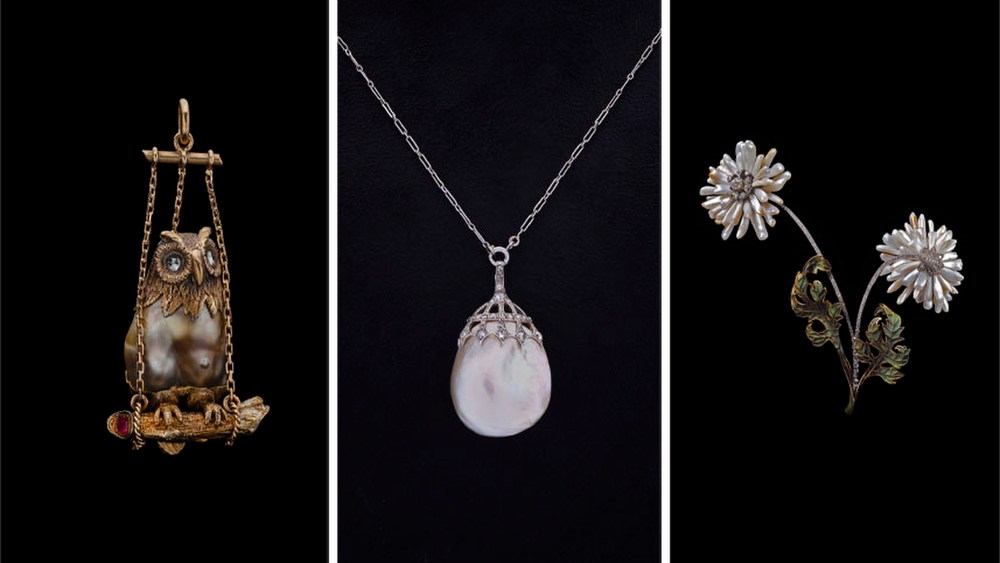PARIS — Did you know that in 1900 there were 300 natural pearl dealers here between numbers 1 and 100 Rue Lafayette?
It was a passing mention of this in a scientific book that caught the attention of Olivier Segura, gemologist and director of L’École Asia-Pacific, School of Jewelry Arts, and set the wheels for the “Paris, City of Pearls” exhibition running until June 1 at the Hôtel de Mercy-Argenteau in motion.
“It’s incredible because that means there were several in most buildings,” he told WWD at a walkthrough ahead of its opening on Thursday. “But when people asked why and how as well as why they were now gone, I was incapable of answering.”
JAR, sheep’s head brooch, 2006, natural pearls, cabochon star sapphires, aluminum, silver, gold. Private collection.
Courtesy of L’ÉCOLE, School of Jewelry Arts
What started as a three-month research project for Léonard Pouy, the school’s content and transmission manager who is a doctor in art history, to get a sense of the facts turned into this 100-piece exhibition and accompanying 240-page catalogue.
But before diving into their halcyon decades in Paris between the 1860s and the 1930s, the exhibition starts by debunking the myth that pearls are formed when a mollusk swallows a grain of sand.
While the exact causes that trigger the formation of a pearl still elude science, conditions such as temperature, salinity and the animal’s nutrition greatly influence the result.
Not to mention luck. Statistically, one out of every 100 oysters contains a natural pearl and out of 100 of those, only one can be considered jewelry-grade and another one-hundredth of these is suitable for high jewelers.

Jean-Gabriel Domergue, advertisement for Van Cleef & Arpels from 1923.
Courtesy of L’ÉCOLE, School of Jewelry Arts
“That’s more than 10 million oysters you have to fish to get a high jewelry-grade pearl,” said Segura. “Imagine how many you need to get the color assortment for a whole necklace.”
Ever present throughout history, interest in pearls grew at the end of the 19th century and reached a fever pitch in the early years of the 20th century. “The gradual rise turned into a pearl bubble,” said Pouy.
New records were reached for the price per carat, as seen in the sales of pearl jewelry from Princess Mathilde, a niece of Napoléon Bonaparte, and dispersion of the collection of the last monarch of the Ottoman Empire, Sultan Abdulhamid II.
Drawn from the collections of institutions ranging from Musée des Arts Décoratifs to the Albion Art Jewellery Institute, exhibits ranging from a set designed by Frédéric Boucheron for British aristocrat Lady Wolverton and a cascade of Cartier pearls to a set by Boisvin and a beaded evening bag by Van Cleef & Arpels showcase the range of the biomineral gem.
Then there is the Persian Gulf that helped pearls rain and reign in Paris throughout the period.
The reason was called Léonard Rosenthal. This Paris-based merchant from the turn of the 20th century took advantage of a micro-crisis that saw local fishermen and merchants not getting paid properly.
Arriving with donkeys loaded down with sacks of coins, “the psychological effect was instantaneous,” said Pouy. “Everyone wanted to work with him, particularly because he offered higher prices than his competitors, having cut out intermediaries in Bombay and London.”

Dusausoy brooch circa 1930 in natural pearls, diamonds, platinum.
Courtesy of L’ÉCOLE, School of Jewelry Arts
In his prosperous wake, a whole ecosystem sprung up in the French capital. By the dawn of the 1920s, pearls were everywhere, from jewels and clothing to films and advertising, such as the dozens of illustrated examples lining the walls of the exhibition.
The boom was such that even traditional gemstone merchants were offering pearls but their influence didn’t stop there. “Pearls were worth more than diamonds and everyone was coming to Paris to purchase them,” said Segura.
“It’s hard to imagine the extent to which pearls financed the cultural, economic, artistic and even scientific development of Paris and France in general,” said Pouy. Many investments were backed by the industry’s wealthy merchants, including the Galerie des Champs-Elysées shopping arcade.
By the time of the 1925 International Exhibition of Modern Decorative and Industrial Arts, pearls in general were a byword for elegance and modernity. But for natural pearls, it was the tipping point toward decline.
Not only was there overfishing but high-quality cultured pearls arrived, such as those from Mikimoto, first imported by Parisian jeweler Worms, followed by the 1929 financial crisis.
The Holocaust put paid to the Paris pearl industry, as many merchants were of Jewish descent and were murdered along with their families. Those who escaped headed to the U.S. or Polynesia, where some set up pearl farms.
While natural pearls have lost some of their luster for the wider jewelry consumer, they still have a radiant future, especially in high jewelry. A final section shows recent high jewelry creations by the likes of JAR or Athens-based jeweler Theodoros.
And jewelers interested in natural pearls still have plenty to work with, according to the curators. There’s existing stock passed down through familial lines and companies, and there is still a small but substantial production in certain countries.
“It’s far from being a dead or vanished material,” said Pouy.

